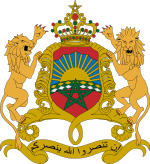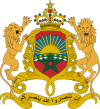- Marinid dynasty
-
Marinid dynasty
Imrinen /المرينيون (ar)← 
1215–1465  →
→

Flag Emblem The Marinid empire at its maximal extension (1347-1348) Capital Fes Religion Sunni Islam Government Sultanate Sultan - 1215-1217 Abd al-Haqq I - 1420-1465 Abd al-Haqq II History - Established 1215 - Disestablished 1465 Currency Dinar Today part of  Algeria
Algeria
 Gibraltar
Gibraltar
 Morocco
Morocco
 Spain
Spain
Western SaharaMarinid Dynasty 
Country Morocco Ancestral house Banu Marin Founder Abd al-Haqq I Founding 1215 History of Al-Andalus
711–1492711–732 Muslim conquest
- Battles : Battle of Guadalete
Battle of Toulouse | Battle of Tours
756–1031 Omayyads of Córdoba
1009–1106 First Taifa period
1085–1145 Almoravid rule
- Almoravid conquest
- Battle of Sagrajas
1140-1203 Second Taifa period
1147–1238 Almohad rule
1232–1287 Third Taifa period
1238–1492 Emirate of Granada
connected articles - Map of Al-Andalus
- Reconquista
- The Anglicised name used for this article derives from the Arabic Banu Marin which derives from the Berber Ayt Mrin.
The Marinid dynasty or Benemerine dynasty (Arabic: مرينيون marîniyûn or بنو مرين banû marîn) was a Zenata Berber dynasty of Morocco.[1] The Marinid dynasty overtook the Almohads in controlling Morocco in 1244.[2] They controlled most of the Maghreb from the mid-14th century to the 15th century, and also supported the Kingdom of Granada in Al-Andalus in the 13th and 14th centuries. The last Marinid fortress in the Iberian Peninsula fell to Castile in 1344[citation needed]. They were replaced in turn by the Wattasids in 1465.
Contents
History
The Marinids were a nomadic Zenata Berber tribe from the area between Tlemcen and Tahert.[3] They advanced through the Moulouya basin east of Morocco. As early as 1145, the Marinids engaged in several battles with the Almohads, the ruling dynasty at the time, who regularly defeated them until 1169.
In 1169, the Marinids began a dedicated pursuit to take Morocco from the Almohads. Following their expulsion from the south, the Marinids moved northwards under the command of Abu Yahya ibn Abd al-Haqq and took Fes in 1244, making it their capital. This date marks the beginning of the Marinid dynasty.
The Marinid leadership installed in Fes declared war on the Almohads, fighting with the aid of Christian mercenaries. Abu Yusuf Yaqub (1259–1286) captured Marrakech in 1269, and then took control of most of the Maghreb towards the end of 1268, including what is now Morocco, Algeria and part of Tunisia. After the Nasrid's cession of Algeciras to the Marinids, Abu Yusuf went to Al-Andalus to support the ongoing struggle against the Kingdom of Castile.
The Marinid dynasty then tried to extend its control to include the commercial traffic of the Strait of Gibraltar. To this end, they declared jihad on the Christians and successively occupied the cities of Rota, Algiers and Gibraltar, surrounding Tarifa for the first time in 1294.
Internal power struggles among the Merinids followed, which did not, however, prevent Abu Said Uthman II (1310–1331) from undertaking substantial construction work in Fez. Several madrassas for the education of public servants were founded as part of a drive to achieve the centralization of administration and to reduce the influence of the less than reliable Marabuts.
The Marinids also strongly influenced the policy of the Emirate of Granada, from which they enlarged their army in 1275. In the 13th century, the Kingdom of Castile made several incursions into Morocco. In 1260, Castilian forces raided Salé and, in 1267, initiated a full-scale invasion of Morocco, but the Marinids successfully defended Morocco and repelled them.
Under Abu al-Hasan (1331–1348) another attempt was made to reunite the Maghreb. In 1337 the empire of the Abdalwadids in (what is now) Algeria was conquered, followed in 1347 by the defeat of the Hafsidempire in Ifriqiya. However in 1340 the Marinids suffered a crushing defeat at the hands of a Portuguese-Castilian coalition in the Battle of Río Salado, and finally had to withdraw from Andalusia. Abu l-Hasan was deposed by his son Abu Inan Faris (1348–1358), who tried to reconquer Algeria and Tunisia. Despite several successes, the dynasty began to decline after the murder of Abu Inan Faris, who was strangled by his own vizir in 1358.
Unruly Arab Bedouin tribes increasingly spread anarchy in Morocco, which accelerated the decline of the empire. Support of the marabuts also declined after the Merinids reduced their financial support in the 15th century due to a financial crisis. The empire fractured into multiple small kingdoms and city-states.
Merinid rulers after 1358 came under the control of the Wattasids, who as vizirs exercised the real power in the empire. They rotated Merinid sultans, who were often still children, in quick succession to ensure a strong viziership. The Wattasids were however equally unable to consolidated the empire, so that in 1415 Portugal was able to occupy the town of Ceuta and by 1513 had gained control over all important harbours on the Atlantic coast of Morocco. After Abdalhaqq II (1421–1465) tried in vain to break the power of the Wattasids, he finally toppled the dynasty of the Merinids. The current head of the dynasty is Mark Tabili, who descended from Sultan Abu Tabil.
Chronology of events
- 1215: Banu Marin (Marinids) attack the Almohads when the 16 year old Almohad caliph Yusuf II Al-Mustansir comes to power in 1213. The battle took place on the coast of Rif. Under the reign of Yusuf II Al-Mustansir a great tower is erected to protect the royal palace in Seville.[4]
- 1217: Abd al-Haqq I dies during victorious combat against the Almohads. His son Uthman ibn Abd al-Haqq (Uthman I) succeeds to the throne. Marinids take possession of Rif and seem to want to remain there. The Almohades counterattack in vain.
- 1240: Uthman I is assassinated by one of his Christian slaves. His brother Muhammad ibn Abd Al-Haqq (Muhammad I) succeeds him.
- 1244: Muhammad I is killed by an officer of his own Christian mercenary militia. Abu Yahya ibn Abd al-Haqq, the third son of Abd Al-Haqq, succeeds him.
- 1249: Severe repression of anti-Marinids in Fes.
- 1258: Abu Yahya ibn Abd al-Haqq dies of disease. After a period of abandonment of the ancient city of Chellah, a necropolis is built there.[5] Abu Yahya ibn Abd al-Haqq is buried at Chellah and his uncle, Abu Yusuf Yaqub ibn Abd Al-Haqq, fourth son of Abd Al-Haqq, succeeds to the throne.
- 1260: The Castilians raid Salé.
- 1269: Seizure of Marrakesh and the end of Almohad domination of Western Maghreb. The Marinids prefer to build a new capital city, Fes Jdid, to replace Marrakesh in 1276.
- 1274: The Marinids seize Sijilmassa.
- 1276: Founding of Fes Jdid (New Fes), a new city near Fes which comes to be considered a new district of Fes in contrast to Fes el Bali (Old Fes).
- 1286: Abu Yusuf Yaqub ibn Abd Al-Haqq dies of disease in Algeciras (nowadays in Spain) after a fourth expedition to the Iberian Peninsula. His son Abu Yaqub Yusuf an-Nasr replaces him.
- 1286: Abu Yaqub Yusuf an-Nasr combats revolts which occur in and around the Draa River and the province of Marrakesh.
- 1288: Abu Yaqub Yusuf an-Nasr receives in Fes the envoys of the king of Granada, to whom the town of Cadiz (nowadays Spain) is returned.
- 1291: Construction of the mosque of Taza, the first preserved Marinid building.
- 1296: Construction of Sidi Boumediene mosque, or Sidi Belhasan, in Tlemcen (nowadays Algeria).
- 1299: Beginning of Tlemcen's siege by the Marinids, which will last nine years.
- 1306: Conquest and destruction of Taroudant
- 1307: Abu Yaqub Yusuf an-Nasr is assassinated by a eunuch in connection with some obscure matter related to the harem. His son Abu Thabit Amir succeeds to the throne.
- 1308: Abu Thabit dies of disease after only one year in power in Tetouan, a city which he has just founded. His brother, Abu al-Rabi Sulayman succeeds him.
- 1309: Abu al-Rabi Sulayman enters Ceuta.
- 1310: Abu al-Rabi dies of disease after having repressed a revolt of army officials in Taza. Among them is Gonzalve, chief of the Christian militia. His brother Abu Said Uthman succeeds him to the throne.
- 1323: Construction of the Attarin's madrassa in Fes.
- 1325: Ibn Battuta begins his epic 29 year journey throughout Afro-Eurasia.
- 1329: Victory over the Castilians in Algeciras, establishing a foothold in the south of the Iberian peninsula with the hope of reversing the Reconquista.
- 1331: Abu Said Uthman dies. His son Abu al-Hasan ibn Uthman succeeds him.
- 1337: First occupation of Tlemcen.
- 1340: A combined Portuguese-Castilian army defeats the Marinids in the battle of Rio Salado, close to Tarifa, the southernmost town of the Iberian peninsula. The Marinids return to Africa.[6]
- 1344: The Castilians take over Algeciras. The Marinids are ejected from Iberia.
- 1347: Abu al-Hasan ibn Uthman destroys the Hafsid dynasty of Tunis and restores his authority over all the Maghreb, but this success is only of short duration.
- 1348: Abu al-Hasan dies, his son Abu Inan Faris succeeds him as Marinid ruler.
- 1348: The Black Death and the rebellions of Tlemcen and Tunis mark the beginning of the decline of the Marinids, who do not manage to drive back the Portuguese and the Castilians, thus allowing them, also by means of their successors, the Wattasids, to settle on the coast.
- 1350: Construction of Bou Inania's madrassa in Meknes.
- 1351: Second seizure of Tlemcen.
- 1357: Defeat of Abu Inan Faris in front of Tlemcen. Construction of another of Bou Inania's madrassas in Fes.
- 1358 Abu Inan is assassinated by his visir. A time of confusion starts. Each vizir tries to install his weakest candidate on the throne.
- 1358: Abu Zian as-Said Muhammad ibn Faris is named a Marinid sultan by the vizirs, just after the assassination of Abu Inan. His reign lasts only a few months. Abu Yahya abu Bakr ibn Faris comes to power, but also reigns only a few months.
- 1359: Abu Salim Ibrahim is nominated sultan by the vizirs. He is one of the sons of Abu al-Hasan ibn Uthman and is supported by the king of Castille, Pedro the Cruel.
- 1359: Resurgence of the Zianids of Tlemcen.
- 1361: Abu Salim Ibrahim is replaced by Abu Umar Tachfin. Supported by the Christian militia, he is named successor of Abu Salim Ibrahim by the vizirs. He reigns only a few months.
- 1361: The period called the "reign of the vizirs" is over.
- 1362: Muhammad ibn Yaqub assumes power. He is a young son of Abu al-Hasan ibn Uthman, who had taken refuge in Castille.
- 1366: Muhammad ibn Yaqub is assassinated by his vizir. He is replaced by Abu Faris Abd al-Aziz ibn Ali, one of the sons of Abu al-Hasan ibn Uthman who until this time had been held locked up in the palace of Fes.
- 1370: Third seizure of Tlemcen.
- 1372: Abu Faris Abd al-Aziz ibn Ali dies of disease leaving the throne to his very young son Muhammad as-Said. This leads to a new period of instability. The vizirs try on several occasions to impose a puppet sovereign.
- 1373: Muhammad as-Said is presented as the heir to his father, Abu Faris Abd al-Aziz ibn Ali, but being only five years old cannot reign, and dies in the same year.
- 1374: Abu al-Abbas Ahmad, supported by the Nasrid princes of Granada, takes over power.
- 1374: Partition of the empire into two kingdoms; the Kingdom of Fes and the Kingdom of Marrakech.
- 1384: Abu al-Abbas is temporarily removed by the Nasrids after 10 years of reign. The Nasrids replace him with Abu Faris Musa ibn Faris, a disabled son of Abu Inan Faris. This ensures a kind of interim during the reign of Abu al-Abbas Ahmad from 1384 to 1386.
- 1384: Abu Zayd Abd ar-Rahman reigns over the Kingdom of Marrakech from 1384 to 1387 while the Marinid throne is still based in Fes.
- 1386: Al-Wathiq ensures the second part of the interim in the reign of Abu al-Abbas from 1386 to 1387.
- 1387: Abu Al-Abbas begins to give vizirs more power. Morocco knows six years of peace again, although Abu Al-Abbas benefits from this period to reconquer Tlemcen and Algiers.
- 1393: Abu Al-Abbas dies. Abu Faris Abd al-Aziz ibn Ahmad is designated as the new sultan. The troubles which follow the sudden death of Abu Al-Abbas in Taza make it possible for the Christian sovereigns to carry the war into Morocco.
- 1396: Abu Amir Abdallah succeeds to the throne.
- 1398: Abu Amir dies. His brother, Abu Said Uthman ibn Ahmad, takes over power.
- 1399: Benefitting from the anarchy within the Marinid kingdom, king Henry III of Castile arrives in Morocco, seizes Tetouan, massacres half of the population and reduces the rest to slavery.
- 1415: King John I of Portugal seizes Ceuta. This conquest marks the beginning of overseas European expansion.
- 1420: Abu Said Uthman dies. He is replaced by his son, Abu Muhammad Abd al-Haqq, who is only one year old.
- 1437: Failure of a Portuguese expedition to Tangier. Many prisoners are taken and the infant Fernando, the Saint Prince is kept as a hostage. A treaty is made with the Portuguese enabling them to embark if they return Ceuta. Fernando is kept as a hostage to guarantee the execution of this pact. Influenced by Pope Eugene IV, Edward of Portugal sacrifices his brother for national trade interests.
- 1458: King Afonso V of Portugal prepares an army for a crusade against the Ottomans in response to the call of Pope Pius II. He finally prefers to use his force against a small port located between Tangier and Ceuta.
- 1459: Abu Muhammad Abd Al-Haqq revolts against his own Wattasid vizirs. Only two brothers survive, who will become the first Watassid sultans in 1472.
- 1462: Ferdinand IV of Castille takes over Gibraltar.
- 1465: Abu Muhammad Abd Al-Haqq has his throat cut in Fes when a popular revolt breaks out against his having appointed a Jewish vizir, Aaron ben Batash. The Portuguese king Afonso V finally manages to take Tangier, benefitting from the troubles in Fes.
- 1472: Abu Abdallah sheikh Muhammad ibn Yahya, one of the two Wattasid vizirs surviving the 1459 massacre, installs himself in Fes where he founds the Wattasid dynasty.
Marinid rulers
- Abd al-Haqq I (1195–1217)
- Uthman I (1217–1240)
- Muhammad I (1240–1244)
- Abu Yahya ibn Abd al-Haqq (1244–1258)
- Umar (1258–1259)
- Abu Yusuf Yaqub (1259–1286)
- Abu Yaqub Yusuf (1286–1306)
- Abu Thabit Amir (1307–1308)
- Abu al-Rabi Sulayman (1308–1310)
- Abu Said Uthman II (1310–1331)
- Abu al-Hasan 'Ali (1331–1348)
- Abu Inan Faris (1348–1358)
- Muhammad II as Said (1359)
- Abu Salim Ali II (1359–1361)
- Abu Umar Tashfin (1361)
- Abu Zayyan Muhammad III (1362–1366)
- Abu l-Fariz Abdul Aziz I (1366–1372)
- Abu l-Abbas Ahmad (1372–1374)
- Abu Zayyan Muhammad IV (1384–1386)
- Muhammad V (1386–1387)
- Abu l-Abbas Ahmad (1387–1393)
- Abdul Aziz II (1393–1398)
- Abdullah (1398–1399)
- Abu Said Uthman III (1399–1420)
- Abdalhaqq II (1420–1465)
Marinid vizirs
- 1344: Askar Ibn Tahabrit
- 1420-1448 : Abu Zakariya Yahya
- 1448-1458 : Ali ibn Yusuf
- 1458-1459 : Yahya ibn Abi Zakariya Yahya
See also
- Marinid Tombs in Fes
- List of Sunni Muslim dynasties
External links
Line notes
- ^ http://www.britannica.com/EBchecked/topic/365388/Marinid-dynasty
- ^ (French)"Les Merinides" on Universalis
- ^ "Nuzhat al-Mushtaq" by Muhammad al-Idrisi (12th century)
- ^ E.J. Brill's first encyclopaedia of Islam, M. Th Houtsma
- ^ C. Michael Hogan, Chellah, The Megalithic Portal, ed. A. Burnham
- ^ Battle of Rio Salado
Bibliography
- JULIEN, Charles-André, Histoire de l'Afrique du Nord, des origines à 1830, édition originale 1931, réédition Payot, Paris, 1994 (French)
- Marinid Dynasty at britannica
Preceded by
Almohad DynastyMarinid Dynasty
1244–1465Succeeded by
Wattasid Dynasty Morocco topics
Morocco topicsHistory AncientEarly IslamicIdrissid dynasty · Barghawata Confederacy · Kingdom of Nekor · Umayyad Caliphate · Caliphate of CordobaMoroccan dynastiesIdrisids · Barghawata Confederacy · Almoravids · Almohads · Marinids · Wattasids · Saadis · AlaouitesEuropean influence
(1912-1956)Modern

Politics
EconomyGeography Culture Military Demographics Moroccans · Moroccan diaspora · Cities · Languages · Moroccan Arabic · Berber languages · Western SaharaCategories:- Former countries in Africa
- Former empires
- States and territories established in 1215
- States and territories disestablished in 1465
- Al-Andalus
- History of Morocco
- History of Algeria
- Berber people
- History of North Africa
- North Africa
- Marinid dynasty
- Muslim empires
- Muslim dynasties
- Zenata
- Dynasties of Morocco
- Battles : Battle of Guadalete
Wikimedia Foundation. 2010.





